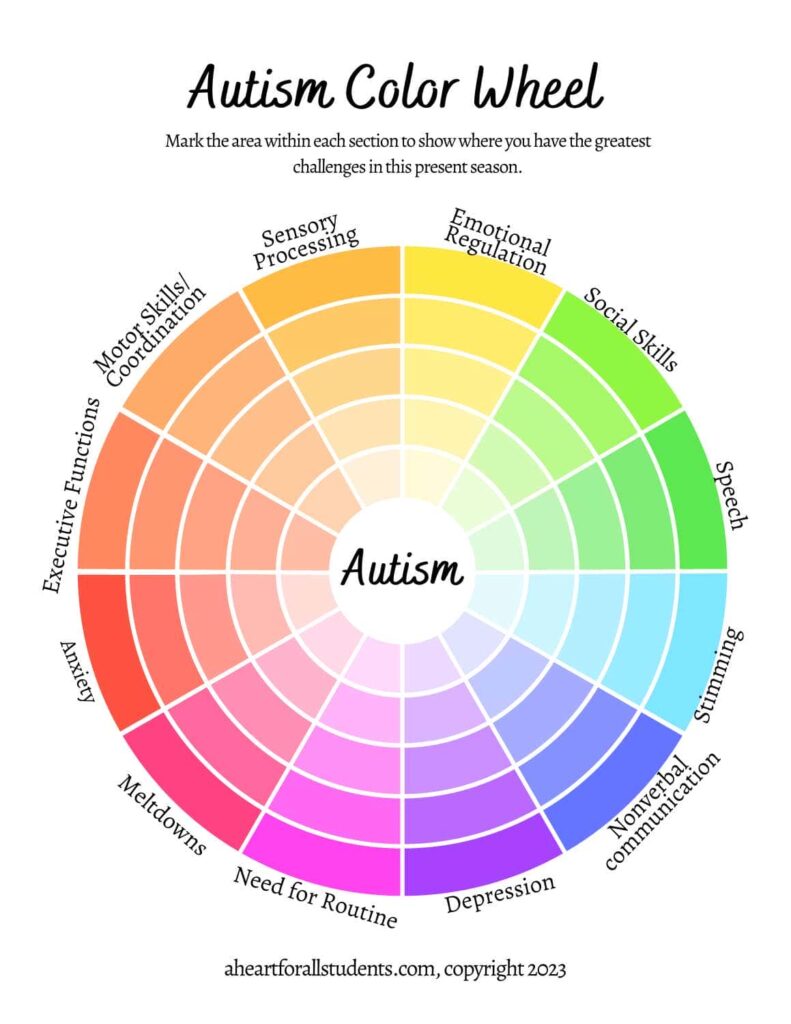
Autism is a complex, multifaceted condition that affects individuals in diverse ways. Traditionally, the term “Autism Spectrum Disorder” (ASD) has been used to describe this range of conditions, emphasizing the wide variability in challenges and strengths among those diagnosed.
However, in recent years, the Autism Wheel has emerged as a new model for understanding and representing autism, offering a more nuanced perspective. This blog post delves into the concepts of the Autism Spectrum and the Autism Wheel, explaining how to read the Autism Wheel and discussing why it is increasingly being seen as a replacement for the spectrum model.
What is the Autism Spectrum?
The term “Autism Spectrum” refers to the broad range of conditions characterized by challenges with social skills, repetitive behaviors, speech, and nonverbal communication, as well as by unique strengths and differences. The use of “spectrum” in ASD highlights the idea that no two individuals with autism are alike; people with autism can have a wide range of skills and abilities, from highly skilled to severely challenged. This spectrum includes conditions that were once considered separate—such as Asperger syndrome, childhood disintegrative disorder, and pervasive developmental disorders not otherwise specified (PDD-NOS).
The spectrum model has been instrumental in advancing the understanding that autism cannot be boxed into a single category. It acknowledges the variability in how autism manifests, pushing for personalized approaches to support and intervention. However, some critics argue that the spectrum metaphor is too linear and fails to capture the complex, multi-dimensional nature of autism.
What is the Autism Wheel?
The Autism Wheel is a conceptual model designed to address some of the limitations of the spectrum concept by offering a more comprehensive and detailed representation of the diverse ways autism can affect an individual.
(Source)
The Autism Wheel visually represents autism as a wheel with several spokes, each spoke representing different characteristics or challenges associated with autism. These include:
- Social skill
- Sensory processing
- Motor skills
- Executive functioning
- Emotional regulation
- Special interests or talents.
Unlike the linear representation of the spectrum, the wheel model allows for a more individualized portrayal of autism, showing how an individual’s profile can vary significantly across different areas. It acknowledges that a person can be highly skilled in one area while facing significant challenges in another, providing a clearer picture of the unique constellation of strengths and challenges each person with autism has.
Note that there is no one “official” version of the Autism Wheel. Different therapists may use slightly different versions of the Wheel, with different spokes.
How to Read the Autism Wheel
Reading the Autism Wheel involves understanding that each spoke represents a different domain of autism characteristics. The wheel can be customized for an individual by marking each spoke to indicate the degree of challenge or strength in that area. For instance, one end of a spoke might represent significant challenges in a particular domain, while the other end represents strengths or typical development in that area.
The center of the wheel might indicate areas of greatest challenge, with the outer edges representing strengths. By marking along each spoke, a profile of an individual’s autism characteristics can be created, visually demonstrating how their abilities and challenges distribute across different aspects of autism.
This personalized approach helps in understanding the specific needs and potential areas for support or development for someone with autism. It also serves as a visual tool for explaining the complexity of autism to educators, clinicians, and family members, facilitating a more tailored approach to support and intervention.
Why the Wheel is Replacing the Spectrum
The shift towards the Autism Wheel from the Autism Spectrum reflects a broader movement within the autism community and among professionals towards models that better capture the complexity of the condition. Here are several reasons why the wheel is gaining traction as a preferred model:
- Multidimensional Representation: The wheel more accurately reflects the multi-dimensional nature of autism, moving beyond the linear limitations of the spectrum. It shows that autism affects multiple areas of functioning, each to varying degrees within an individual.
- Individualized Profiles: By providing a visual representation of an individual’s unique challenges and strengths, the wheel facilitates a more personalized understanding of autism. This can lead to more targeted and effective support strategies.
- Enhanced Communication: The visual nature of the wheel makes it an effective tool for communicating the complex profile of autism to those who may not be familiar with the nuanced differences among individuals on the spectrum. It can help educators, therapists, and family members better understand and support individuals with autism.
- Focus on Strengths and Challenges: The wheel model acknowledges both the challenges and strengths of individuals with autism, encouraging a more balanced perspective that values the unique talents and abilities of people on the autism spectrum.
- Advocacy and Empowerment: The detailed and personalized representation provided by the Autism Wheel can empower individuals with autism and their families to advocate for their specific needs and preferences. It recognizes the individuality of each person’s experience with autism, moving away from a one-size-fits-all approach.
While the Autism Spectrum has played a crucial role in broadening our understanding of autism, the emergence of the Autism Wheel represents a significant step forward. It offers a more nuanced, comprehensive, and individualized model that acknowledges the complex realities of living with autism.
By embracing the Autism Wheel, we can move towards a more inclusive and personalized approach to supporting individuals with autism, ultimately enhancing their quality of life and enabling them to reach their full potential.







